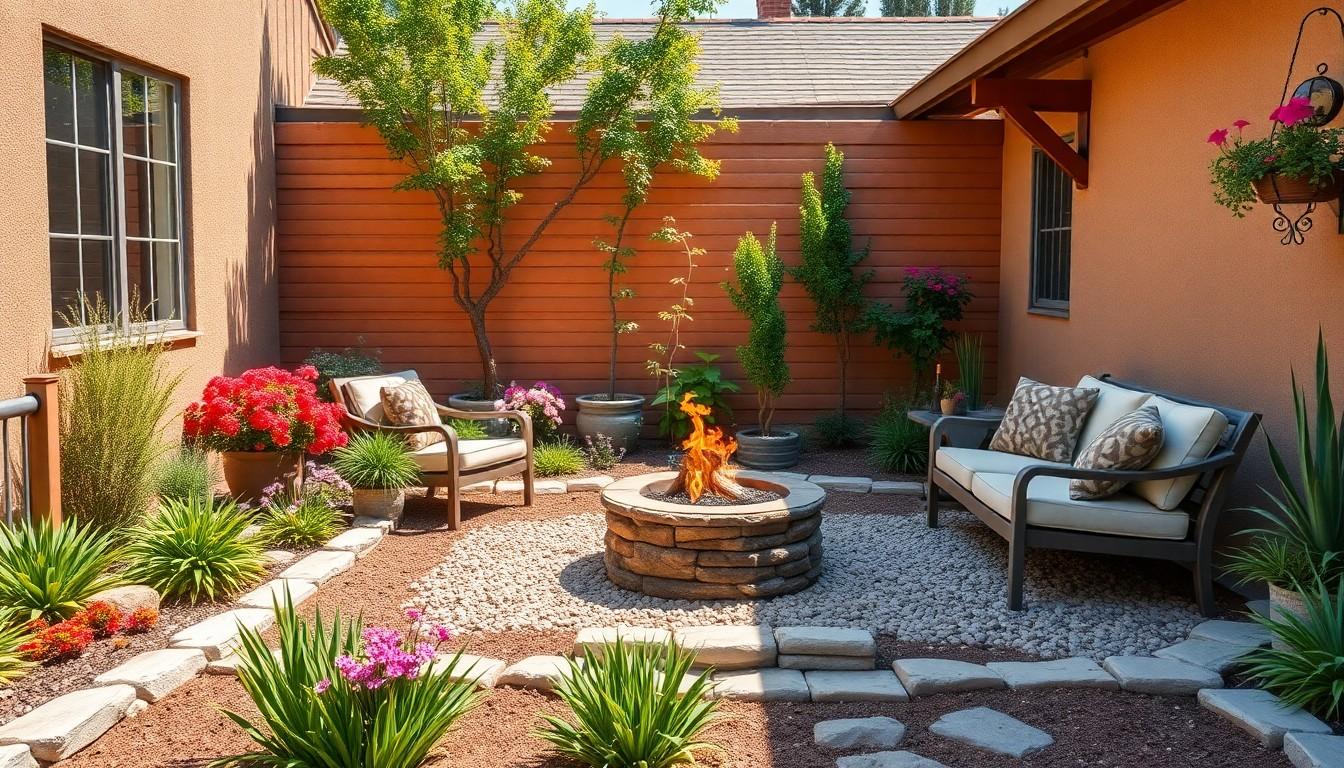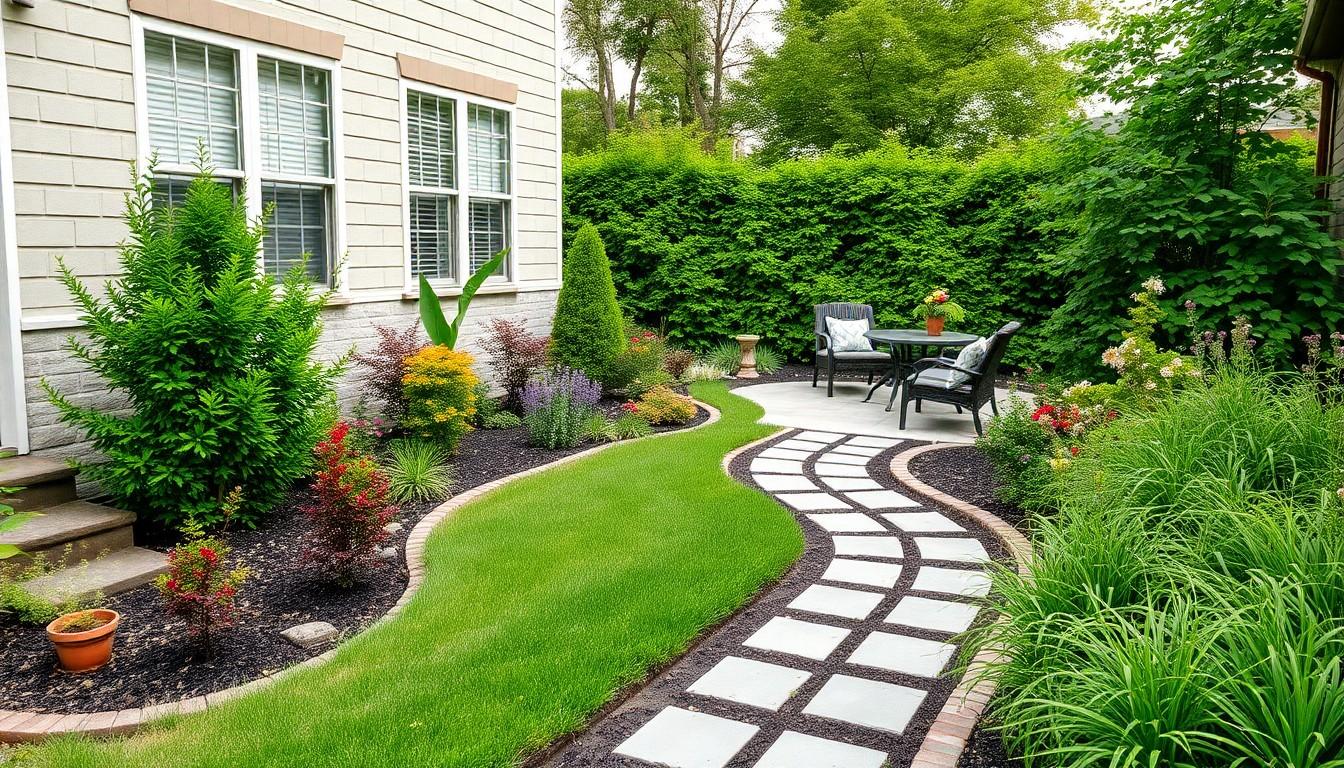A small front yard doesn’t have to mean a small impact. In fact, with the right low-maintenance landscaping ideas, it can be the envy of the neighborhood without demanding all your free time. Who wants to spend weekends sweating over weeds when there’s a couch calling their name?
Understanding Low-Maintenance Landscaping
Low-maintenance landscaping focuses on creating functional outdoor spaces that require minimal upkeep while enhancing aesthetics. Homeowners benefit from reduced labor, increased enjoyment of their yards, and decreased costs over time.
Benefits of Low-Maintenance Landscaping
Low-maintenance landscaping features several advantages. First, it conserves water, often utilizing native plants that thrive locally and reduce irrigation needs. Second, it lessens the time spent on maintenance tasks, allowing for leisure activities instead. Third, it saves money on landscaping services and supplies due to reduced upkeep. Lastly, it promotes environmental sustainability through the use of drought-resistant plants and organic materials, contributing to local ecosystems.
Key Principles to Consider
Several principles guide low-maintenance landscaping choices. Start with selecting native plants, as they adapt easily to local climates and soil conditions. Incorporate mulch to suppress weeds and retain moisture, minimizing watering requirements. Group plants with similar needs to enhance watering efficiency and reduce maintenance efforts. Use hardscaping elements like stone pathways or gravel beds for visual interest and durability. Finally, design with seasonal changes in mind to ensure beauty throughout the year.
Small Yard Layout Ideas

Small yards can offer functional beauty with thoughtful layouts. Strategic planning transforms limited spaces into visually appealing areas.
Defining Your Space
Establish clear boundaries to define the intended use of your small yard. Consider using edging materials, like bricks or stones, to create distinct zones. Elevated features, such as planters or raised beds, add dimension and separate areas for relaxation and gardening. Patio furniture arranged around a fire pit or small table can foster a cozy gathering place. Incorporating pathways guides visitors through the space while adding visual interest.
Choosing the Right Plants
Select plants that thrive in specific conditions of your yard. Native species often require less water and maintenance, making them ideal. Opt for low-growing options like ground covers that add greenery without overwhelming the space. Incorporate a mix of perennials and annuals for continuous blooms throughout the seasons. Drought-resistant plants enhance sustainability and reduce watering needs. Using ornamental grasses can add texture and movement without demanding too much care.
Creative Plant Selections
Selecting the right plants enhances the aesthetic value of a small front yard while ensuring low maintenance. By focusing on both drought-resistant and perennial options, homeowners can achieve beauty with minimal effort.

Drought-Resistant Plants
Drought-resistant plants thrive in low-water conditions, making them ideal for small front yards. Options like succulents, lavender, and agave require little watering once established. These plants also endure harsh sunlight, reducing the need for maintenance. Incorporating ground covers like creeping thyme can provide greenery while minimizing weed growth. Native selections such as ornamental grasses contribute to sustainability while attracting beneficial insects. Overall, drought-resistant plants offer resilience, diversity, and long-lasting beauty in any landscape.
Perennial Choices for Year-Round Color
Perennial plants offer vibrant color throughout different seasons, ensuring continuous visual interest in small yards. Varieties such as coneflowers, daylilies, and sedum bloom reliably each year, creating dynamic focal points. Grouping perennials with varying bloom periods extends the visual allure over time. Low-growing options like coreopsis or phlox work well in smaller spaces without overwhelming the design. Additionally, selecting foliage plants like hostas introduces texture and depth, enhancing the overall landscape. By choosing the right perennials, homeowners enjoy a stunning yard with minimal upkeep requirements.
Hardscape Features
Incorporating hardscape elements simplifies maintenance while enhancing the visual appeal of a small front yard. Thoughtfully selected materials can complement the surrounding landscape and create functional spaces.
Paths and Walkways
Paths and walkways serve as guiding features that direct foot traffic through a front yard. They can be crafted from materials like pavers, bricks, or flagstones, which require minimal upkeep. Concrete options also offer durability and low maintenance, making them suitable choices. Curved or straight designs add variety and can lead to focal points like flowerbeds or seating areas. Consider edging to keep pathways defined and clear from weeds. Lighting along walkways ensures safety and elevates nighttime aesthetics.
Decorative Stones and Gravel
Decorative stones and gravel bring texture and interest to small front yards while serving practical purposes. These materials provide excellent drainage and suppress weed growth, contributing to lower upkeep. River rocks, decomposed granite, and crushed stone can be used effectively for ground cover and highlight specific areas. Areas filled with gravel around plants require little maintenance and allow for easy access during pruning. Using decorative stones in landscaping designs can create visual harmony and establish focal points, complementing other hardscape features effortlessly.
Utilizing Vertical Space
Utilizing vertical space transforms small front yards into eye-catching landscapes with minimal effort. Homeowners maximize their available area while enhancing beauty.
Vertical Gardens and Trellises
Vertical gardens create stunning green walls that minimize ground use. Trellises support climbing plants like jasmine and clematis, adding height and interest. Homeowners find that incorporating these structures improves airflow and sunlight access for plants. Simple maintenance is another perk, with less physical space to tend. Select plants based on your climate for optimal growth and beauty.
Strategic Use of Planters
Strategic use of planters offers flexibility in design and function. Elevating plants in containers reduces ground coverage and minimizes weed issues. Choosing durable materials, like ceramic or resin, enhances style and longevity. Arranging planters in clusters brings visual variety and creates distinct zones. Seasonal changes become easy to manage by swapping out annuals for different looks. Additionally, colorful planters add charm and character, enriching the overall landscape.

